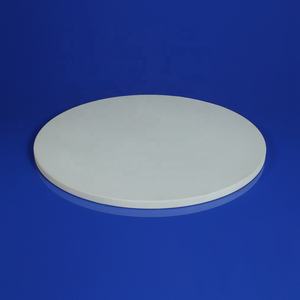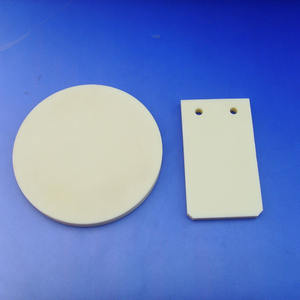1. Material Structure and Ceramic Handling of Alumina Cookware
1.1 From Bauxite to Dense Porcelain: The Production Journey
(Alumina Ceramic Baking Dish)
Alumina ceramic cooking meals are fabricated from light weight aluminum oxide (Al two O FOUR), a synthetic ceramic compound acquired mainly from bauxite ore through the Bayer process.
The raw alumina powder, normally 90– 99.5% pure, undertakes milling to accomplish a great bit size distribution, which is essential for consistent densification during creating and sintering.
To shape the baking dish, the powder is mixed with binders and plasticizers, then developed utilizing techniques such as slip spreading, uniaxial pressing, or isostatic pressing to develop a “environment-friendly” body with the wanted geometry.
After creating, the eco-friendly body is dried and fired in a high-temperature kiln at temperature levels between 1400 ° C and 1600 ° C in an oxidizing environment.
This sintering procedure repel natural additives and induces atomic diffusion, causing a dense, polycrystalline microstructure with marginal porosity– commonly less than 2%.
The final product is a totally consolidated ceramic with high mechanical strength, chemical inertness, and extraordinary thermal stability, making it ideal for repeated direct exposure to oven settings.
1.2 Microstructural Functions and Phase Purity
The performance of alumina baking meals is carefully tied to their microstructure, which contains randomly oriented Al two O five grains ranging from 1 to 10 micrometers in dimension.
Higher-purity solutions (e.g., 99% Al Two O THREE) exhibit greater thermal shock resistance and chemical longevity, while lower-purity qualities might include second stages such as mullite or glassy grain boundary stages that can reduce mechanical toughness at raised temperature levels.
Producers commonly enhance grain dimension and circulation to stabilize sturdiness and thermal conductivity, guaranteeing the dish can endure quick temperature changes without fracturing.
Unlike polished porcelains or porcelain, premium alumina cooking meals are fully thick and non-porous, removing the threat of liquid absorption and microbial growth– a significant advantage for food safety and long-term health.
This inherent impermeability additionally stops taste transfer between various foods, making alumina suitable for versatile kitchen usage.
2. Thermal and Mechanical Behavior in Food Preparation Environments
2.1 Thermal Conductivity, Retention, and Uniform Home heating
Alumina porcelains have moderate thermal conductivity– about 20– 30 W/m · K– greater than the majority of glass or porcelain cookware but less than steels like aluminum or copper.
This building allows gradual and also warmth distribution throughout the dish, lessening locations that can result in uneven food preparation or scorching.
( Alumina Ceramic Baking Dish)
When heated up, alumina exhibits outstanding thermal retention as a result of its high warm capacity, permitting food to remain warm for prolonged periods after elimination from the stove.
This particular is specifically helpful for serving meals, covered dishes, and slow-cooked dishes where constant temperature level is important for texture and flavor growth.
In addition, alumina can hold up against constant use at temperatures approximately 1500 ° C in industrial settings, though common kitchen area stoves operate below 300 ° C, positioning minimal tension on the material.
Its capability to withstand duplicated thermal cycling– such as moving from freezer to oven or oven to countertop– without degradation makes it a resilient choice for modern-day culinary applications.
2.2 Mechanical Strength and Longevity Under Daily Use
Despite being a breakable ceramic, high-density alumina provides superior firmness (Mohs firmness of 9, 2nd just to ruby and cubic boron nitride), making it extremely immune to damaging, abrasion, and surface area wear.
This resistance ensures that the cooking surface area continues to be smooth and non-reactive with time, stopping food deposit buildup and assisting in simple cleaning.
While alumina dishes are not unsusceptible to impact fracture– especially if gone down on difficult surfaces– they are dramatically much more robust than traditional earthenware or ceramic as a result of their fine-grained, low-porosity structure.
Several industrial alumina cooking meals are developed with thick walls and reinforced edges to enhance architectural stability and lower damaging dangers.
Additionally, their chemical inertness ensures no leaching of metallic ions or glaze components into food, also under acidic or alkaline cooking conditions, meeting strict food call security criteria.
3. Useful Advantages Over Standard Cooking Equipment Products
3.1 Contrast with Glass, Steel, and Enameled Steel
Contrasted to borosilicate glass (e.g., Pyrex), alumina ceramics supply superior thermal shock resistance and mechanical stamina, reducing the probability of abrupt fracture throughout temperature changes.
Unlike steel baking trays, which can militarize Maillard responses excessively or react with acidic active ingredients, alumina gives a neutral, non-catalytic surface that preserves food chemistry.
Enameled steel kitchenware, while long lasting, can reveal underlying steel if chipped, leading to rust and contamination; alumina, being fully homogeneous, does not deal with such delamination dangers.
In addition, alumina’s non-porous nature eliminates the demand for flavoring or oiling, unlike cast iron, and prevents the possibility for microbial emigration in microcracks.
These practical benefits placement alumina as a sanitary, durable, and performance-oriented option in both residential and professional kitchens.
3.2 Microwave, Oven, and Fridge Freezer Compatibility
Alumina ceramic cooking meals are totally compatible with standard stoves, convection ovens, griddles, and fridges freezer, making it possible for seamless transitions from storage space to cooking to offering.
They are additionally microwave-safe, as alumina is transparent to microwave radiation and does not produce swirl currents or arcing like metal cooking equipment.
However, customers should make sure that no metal paints or trims are present on ornamental versions, as these can trigger triggering.
The material’s security throughout a broad temperature level array– from ice-cold fridge freezer problems to high-heat broiling– makes it ideal for preparing dishes that need cooling before baking or completing under a grill.
This flexibility sustains modern-day cooking strategies such as sous-vide followed by scorching, or make-ahead meals that are icy and reheated without container transfer.
4. Applications, Sustainability, and Future Advancement
4.1 Culinary Uses and Industrial-Scale Cooking
Alumina ceramic baking recipes are commonly used for roasting veggies, baking covered dishes, preparing gratins, and serving straight at the table because of their visual allure and warm retention.
In business cooking areas, their toughness and resistance to thermal fatigue make them cost-effective gradually in spite of a higher preliminary cost compared to non reusable light weight aluminum trays.
They are likewise used in food processing labs and pilot plants for controlled thermal experiments, where product pureness and dimensional stability are crucial.
Their inertness ensures that speculative outcomes are not skewed by container communications, a key consider recipe development and sensory screening.
4.2 Environmental Effect and Material Development
From a sustainability perspective, alumina porcelains have a high symbolized energy due to sintering at severe temperature levels, yet their durability offsets this through reduced replacement frequency and waste generation.
Unlike single-use light weight aluminum foil or plastic containers, a solitary alumina meal can last decades with correct treatment, adding to circular economic situation concepts in house products.
Ongoing study concentrates on improving durability via composite formulations– such as incorporating zirconia or silicon carbide micro-inclusions– and developing energy-efficient sintering techniques like microwave or trigger plasma sintering for greener production.
In addition, advancements in additive production might soon make it possible for customized, complex-shaped alumina cookware with incorporated thermal management attributes.
In conclusion, alumina ceramic baking meals represent a convergence of innovative materials science and practical kitchen capability.
Their remarkable thermal security, mechanical sturdiness, chemical inertness, and multi-environment compatibility make them superior to lots of standard cooking equipment materials.
As customer demand grows for risk-free, lasting, and high-performance cookware, alumina ceramics are poised to play a significantly central role in contemporary culinary practices.
5. Supplier
Alumina Technology Co., Ltd focus on the research and development, production and sales of aluminum oxide powder, aluminum oxide products, aluminum oxide crucible, etc., serving the electronics, ceramics, chemical and other industries. Since its establishment in 2005, the company has been committed to providing customers with the best products and services. If you are looking for high quality high purity alumina, please feel free to contact us.
Tags: Alumina Ceramic Baking Dish, Alumina Ceramics, alumina
All articles and pictures are from the Internet. If there are any copyright issues, please contact us in time to delete.
Inquiry us

